A Must See! The spectacular autumn leaves of Tohoku and Niigata are a beautiful sight to behold
From the end of September to November, the leaves of deciduous broadleaf trees change color, bathing the mountains and towns of the valleys in a beautiful sea of red, yellow, and orange. Autumn leaves can be seen all over the world, but there is a reason why the autumn leaves in Japan are said to be particularly beautiful.
While foliage in other countries tends to be monochromatic, Japanese foliage, with its abundance of deciduous broad-leaved trees, mixes red, yellow, orange, golden brown, and the green of evergreen trees, creates a beauty similar to that of a nishiki-e (colored woodblock print).
In addition, visitors can enjoy Japan’s natural scenery covered in autumn leaves, creating a unique world by adding the ethereal touch of autumn leaves.
In particular, the Tohoku region, located in northern Japan, is said to be one of the most beautiful locations for beech trees in the country, as it has many beech trees with golden-yellow leaves, as well as a large temperature difference between day and night, which are favorable conditions for beautifully colored autumn leaves.
You can only see these spectacular views of Tohoku's colorfully tinted fields and mountains in the autumn season, making for a special autumn-exclusive activity.
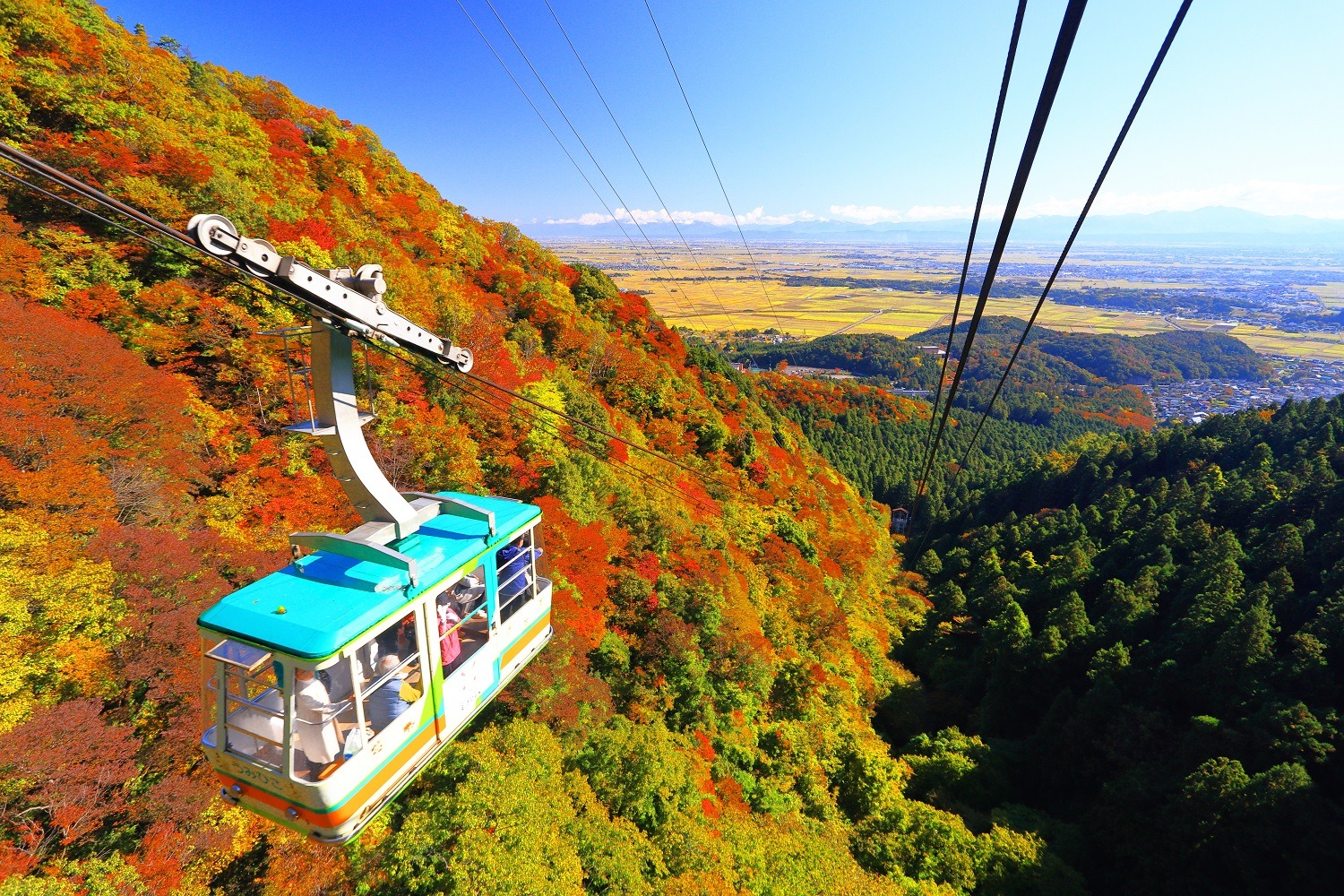
Naruko and Mt. Kurikoma, two of Tohoku's best autumn foliage spots
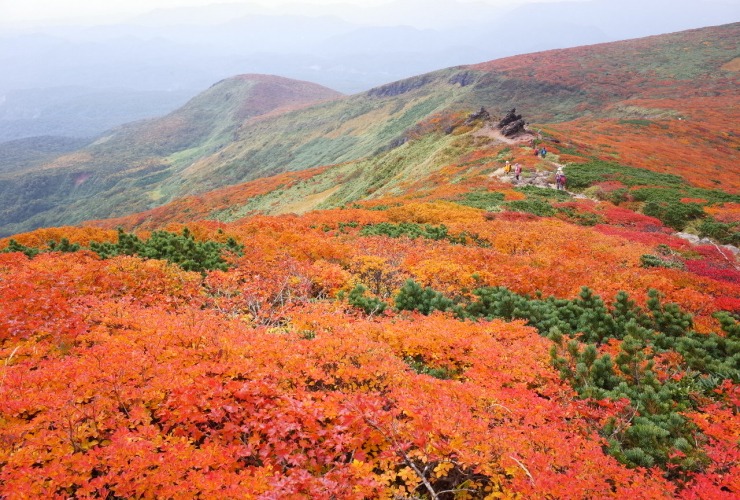
Naruko (Osaki City, Miyagi Prefecture) is accessed by transferring from the Tohoku Shinkansen Line to the Rikuu-East Line, which offers wonderful views of the rural landscape from the train windows. Here you will find Naruko Gorge, which is renowned as one of the best places in Tohoku for autumn foliage.
Naruko Gorge is a grand canyon created by the erosion of the Oya River, with cliffs approximately 100 meters high from the riverbanks extending approximately 2.5 km in length. Fantastic rocks of various shapes line the rock surface, creating a magnificent landscape together with the surrounding trees. During the autumn foliage season, the deep canyon is colored with colorful leaves, transforming it into a spectacular sight. The combination of the beautiful arch of the Ofukazawa Bridge and the autumn leaves is especially impressive, a famous view of Naruko Gorge. You can also see the autumn leaves from the top of the bridge, and if the timing is right, you can see the moment when the Rikuu-East Line train enters and exits the tunnel.
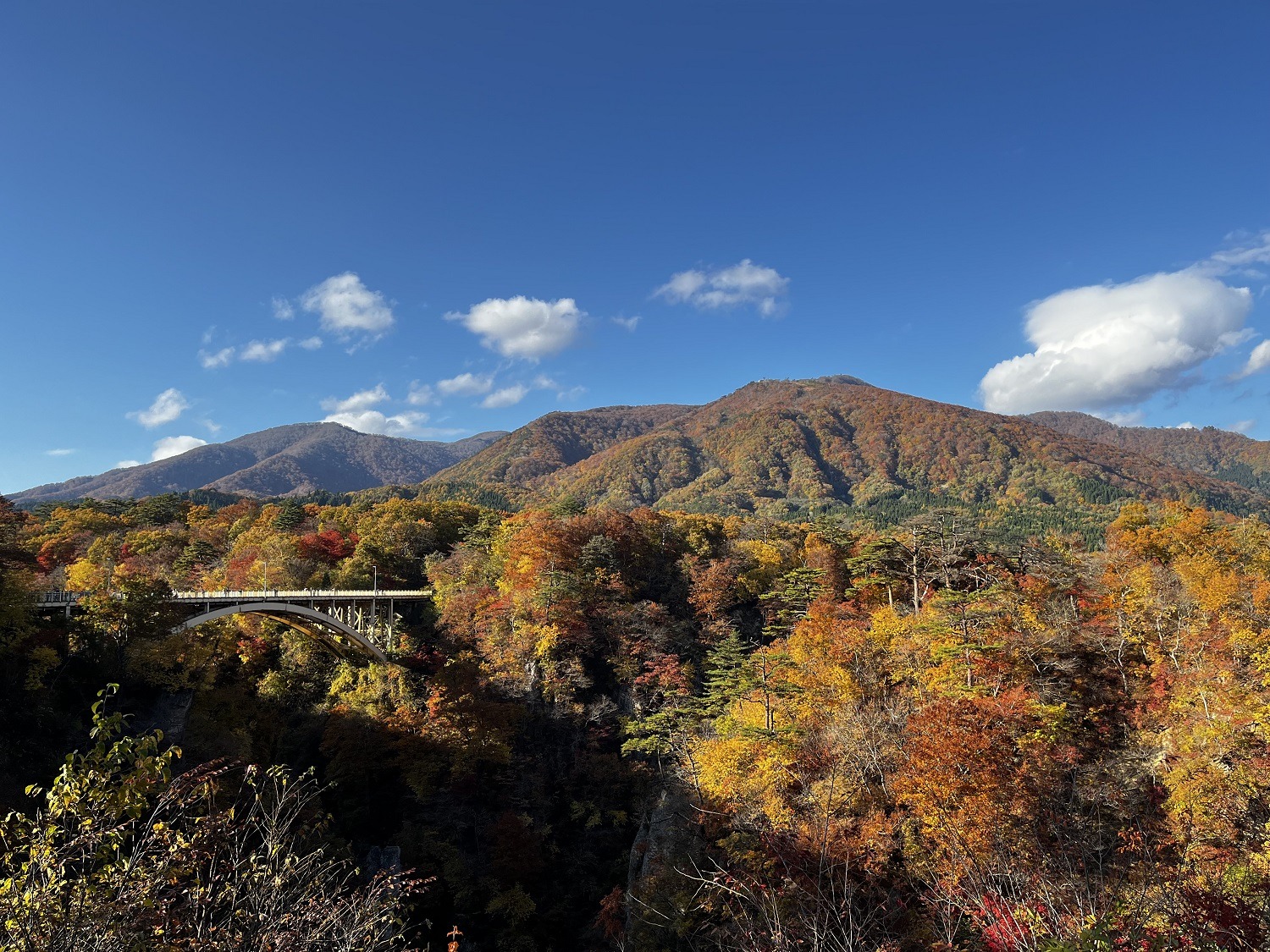 The Narukokyo Rest House is a base for autumn leaf viewing. There is an observatory and observation deck on the premises, where you can see the scenery of Ofukazawa Bridge. Visitors can enjoy snacks and souvenirs, and we recommend local delicacies such as Kuri Dango, which is made by wrapping a whole chestnut and pouring Mitarashi red bean paste over it. Kinoko Jiru is mushroom soup with several kinds of mushrooms and locally grown radish served in a miso-based broth. All of these items are popular during the fall foliage season, so please be aware that they may sell out. There is also a promenade starting from the rest house. If you want to experience the autumn leaves up close, enjoy a stroll along the promenade. The best time to see the autumn leaves at Naruko Gorge is from late October to early November.
The Narukokyo Rest House is a base for autumn leaf viewing. There is an observatory and observation deck on the premises, where you can see the scenery of Ofukazawa Bridge. Visitors can enjoy snacks and souvenirs, and we recommend local delicacies such as Kuri Dango, which is made by wrapping a whole chestnut and pouring Mitarashi red bean paste over it. Kinoko Jiru is mushroom soup with several kinds of mushrooms and locally grown radish served in a miso-based broth. All of these items are popular during the fall foliage season, so please be aware that they may sell out. There is also a promenade starting from the rest house. If you want to experience the autumn leaves up close, enjoy a stroll along the promenade. The best time to see the autumn leaves at Naruko Gorge is from late October to early November.
 If you head north from Naruko Gorge, you will see Mt. Kurikoma which straddles Miyagi, Iwate, and Akita prefectures, and has an altitude of 1,626 meters. In the summer, the area is covered in fields of alpine flowers, but in autumn, the entire mountain is dyed in beautiful autumn leaves. The entire mountain is covered with many deciduous trees such as maples, dodan azaleas, and Japanese rowan, resulting in a large panorama of rich colors.
If you head north from Naruko Gorge, you will see Mt. Kurikoma which straddles Miyagi, Iwate, and Akita prefectures, and has an altitude of 1,626 meters. In the summer, the area is covered in fields of alpine flowers, but in autumn, the entire mountain is dyed in beautiful autumn leaves. The entire mountain is covered with many deciduous trees such as maples, dodan azaleas, and Japanese rowan, resulting in a large panorama of rich colors.
Mt. Kurikoma has nine climbing courses that can be enjoyed by a large range of climbers, from beginners to advanced climbers. There are six courses on the Miyagi Prefecture side, two courses on the Iwate Prefecture side, and one course on the Akita Prefecture side. The central course on the Miyagi Prefecture side is especially popular among climbers because it is the shortest way to the summit, has the least elevation gain, and is easy for beginners to climb. While hiking, take a break and sit down on the gentle slope, and be moved by the amazing views of the autumn leaves that emerge in front of you. Furthermore, from the top of the mountain, when the weather is clear, you can see magnificent views of Mt. Chokai, Mt. Gassan, Mt. Asahi, Mt. Iide, and Mt. Funagata, where the entire mountain surface is tinged with a gradation of red, yellow, orange, and green autumn leaves. The autumn leaves of Mt. Kurikoma are also referred to as the "carpet of the gods," and the beauty of the area is well worthy of the nickname.
To access Mt. Kurikoma from the Miyagi side, you will need to drive from Kurikoma-Kogen Station on the Tohoku Shinkansen. During the autumn foliage season, on weekends a special bus (no reservation required) runs from Kurikoma Kogen Station to Iwakagami-daira, which is the starting point of the central mountain climbing course. The best time to see Mt. Kurikoma is from mid-September to mid-October.
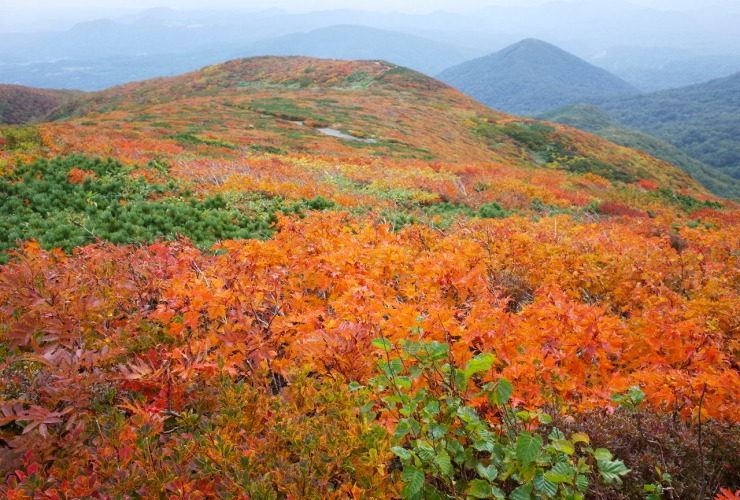 Hot springs are a great way to experience the autumn foliage of Naruko and the Kurikoma Mountains. Naruko has five unique hot spring areas: Naruko, Higashi Naruko, Kawatabi, Nakayamadaira, and Onikobe. It is one of the rare hot spring areas in Japan that has 9 out of the 11 types of hot springs available in Japan. At Mt. Kurikoma, on the Iwate Prefecture side is Sukawa Kogen Onsen which is rare for its highly acidic spring water, and on the Akita Prefecture side is Sukawa Onsen which also has highly acidic spring water. On the Miyagi Prefecture side is a large grouping of hot springs, including Kurikoma Kogen Onsenkyo, close to Iwakagami-daira. Depending on the location, there are hot springs where you can enjoy bathing while admiring the spectacular autumn leaves, so you can fully enjoy the Japanese atmosphere.
Hot springs are a great way to experience the autumn foliage of Naruko and the Kurikoma Mountains. Naruko has five unique hot spring areas: Naruko, Higashi Naruko, Kawatabi, Nakayamadaira, and Onikobe. It is one of the rare hot spring areas in Japan that has 9 out of the 11 types of hot springs available in Japan. At Mt. Kurikoma, on the Iwate Prefecture side is Sukawa Kogen Onsen which is rare for its highly acidic spring water, and on the Akita Prefecture side is Sukawa Onsen which also has highly acidic spring water. On the Miyagi Prefecture side is a large grouping of hot springs, including Kurikoma Kogen Onsenkyo, close to Iwakagami-daira. Depending on the location, there are hot springs where you can enjoy bathing while admiring the spectacular autumn leaves, so you can fully enjoy the Japanese atmosphere.
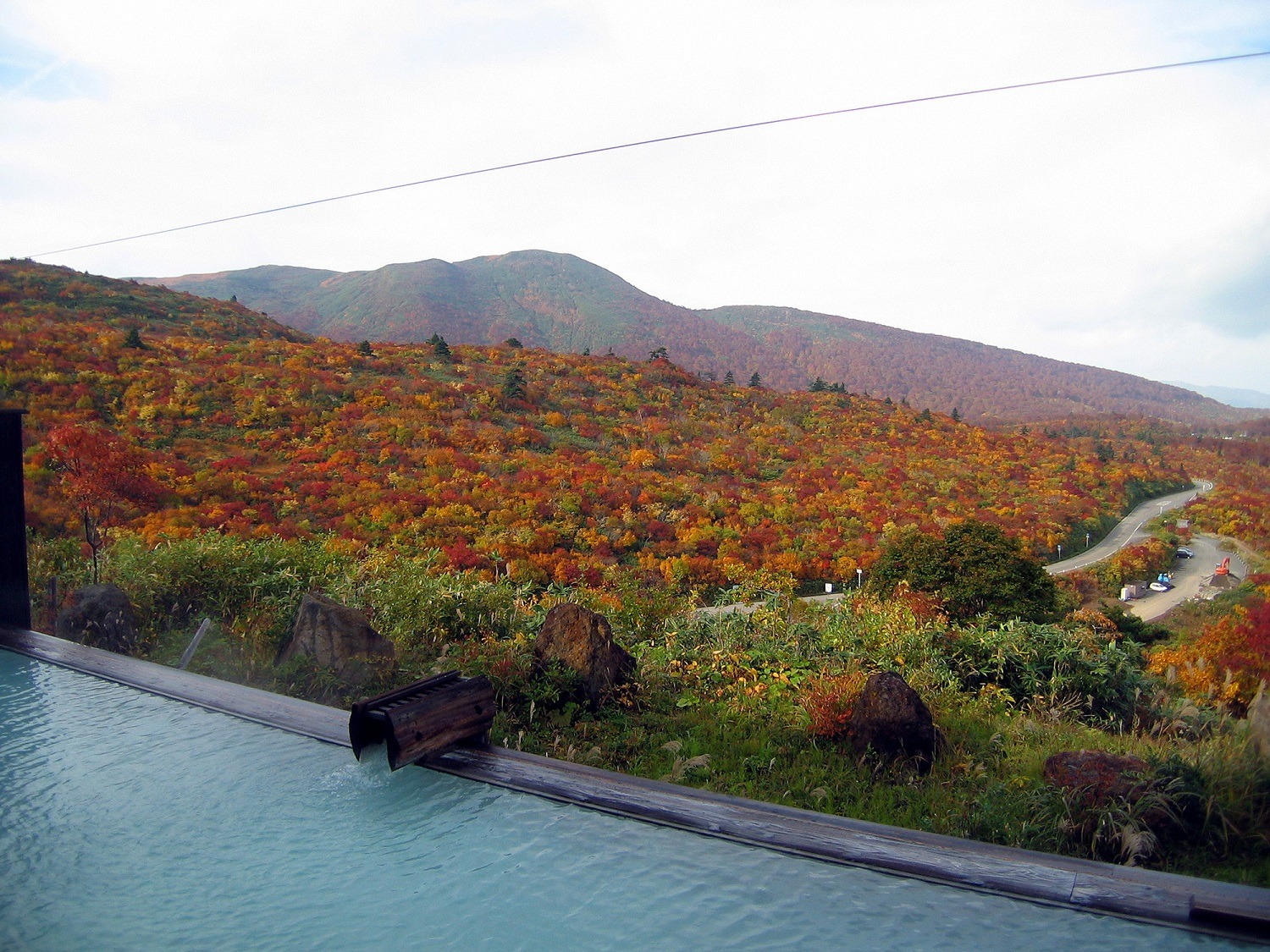
A lesser-known local line, the "JR Tadami Line," runs through the spectacular autumn leaves
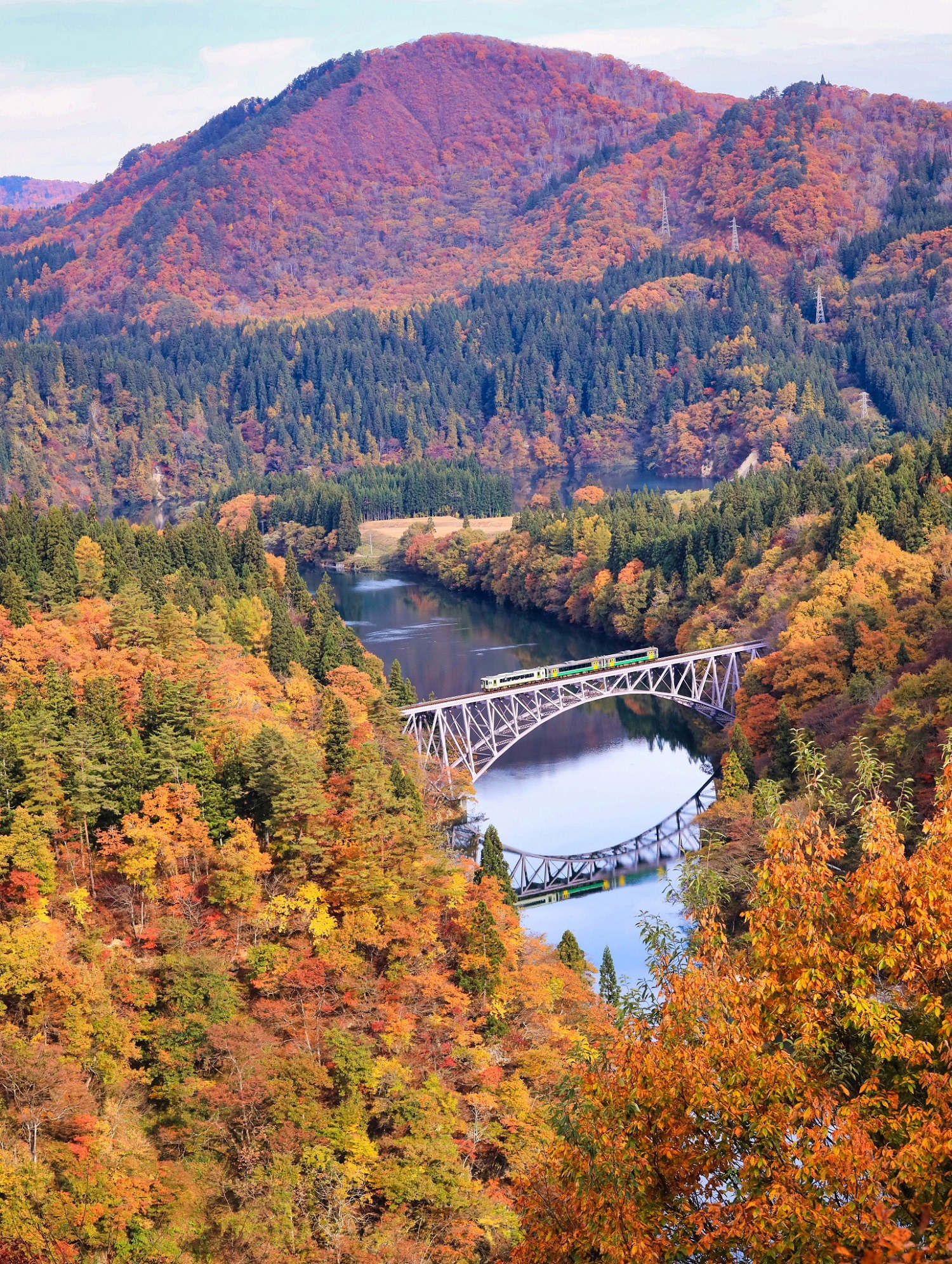
(the First Tadami River Bridge_Photo courtesy of 星 賢孝)
The JR Tadami Line, which connects Aizuwakamatsu in Fukushima Prefecture and Koide in Niigata Prefecture with a total length of about 135km, is a local line known nationwide for its beautiful scenery. From the train window, you can enjoy the unexplored scenery of the Tadami River flowing along the line, majestic mountains, riverside villages, and numerous iron bridges and tunnels. The train is famous not only for the views from the windows, but also for the beauty of the scenery as it runs through a rich and beautiful area of nature, and many photographers from Japan and abroad gather along the line to capture the moment with their cameras.
There are many viewing spots on the Tadami Line, but the most beautiful viewpoint is the First Tadami River Bridge between Aizu-Hinohara Station and Aizu-Nishikata Station. The valley, lined with oak, maple, and larch trees, is colored in a beautiful gradation of red, yellow, and green, and the train slowly passes over the railroad bridge that spans it.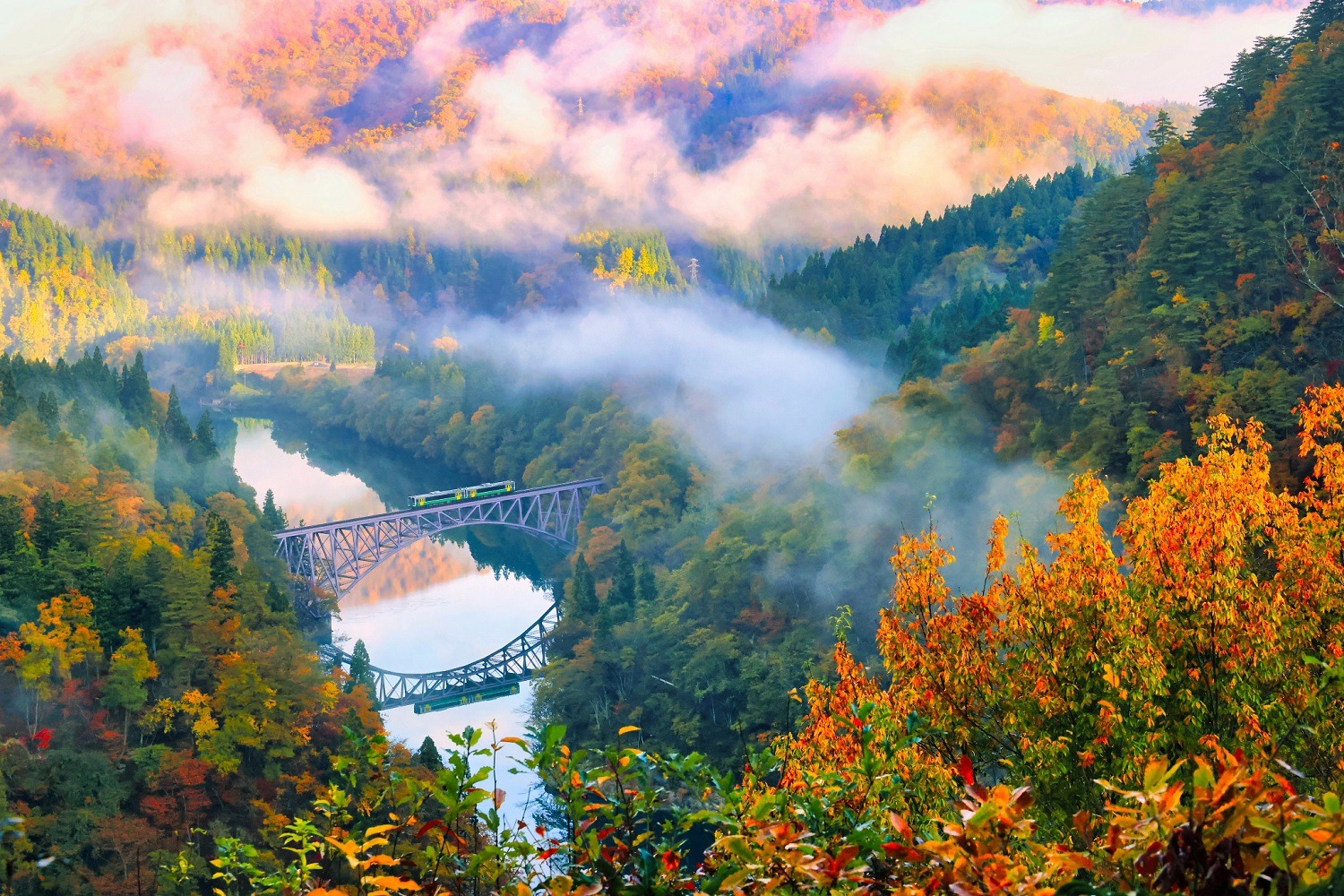
(the First Tadami River Bridge_Photo courtesy of 星 賢孝)
A promenade leads to a viewpoint where you can see this view from a great angle. The starting point of the trail is right next to "Michi-no-Eki Oze-Kaido Mishima-juku" in Mishima Town, and it takes about 10 minutes to reach the viewpoint. Timetables are provided at the viewpoint so that you can see when trains will pass the bridge, allowing you to take perfectly-timed photographs of the autumn leaves as the train passes. Michi-no-Eki, the starting point of the trail, can be reached by the Mishima town bus from Aizu-Miyashita Station (reservation required).
You can also enjoy spectacular views of the bridge while riding the train. When going from the direction of Aizu-Wakamatsu Station, the train will reach the First Tadami River Bridge approximately 2 minutes after departing Aizu-Hinohara Station. When crossing over the river while riding the train, there are snapshot-worthy views in all directions. Enjoy the panoramic view of the Tadami River and autumn leaves from the train window. When heading from the direction of Koide Station, the train will reach the bridge in about 1 minute and 40 seconds after leaving Aizu-Nishikata Station.
When getting off at Aizu-Miyashita Station to go to the First Tadami River Bridge View Spot, there is one more spot for viewing that we also recommend. This is "Miyashita Three Arch Bridge Brothers," which can be viewed from an observation spot that is a 5-minute walk from Aizu-Miyashita Station. This is known as the only scenic spot in Japan with three arch bridges. The highest is the Shinmiyashita Bridge on Route 252. The middle is the Tadami Line Otani River Bridge. The lower one is Miyashita Bridge on Prefectural Route 237. Be sure to capture the rare scenery created by the autumn leaves in this Satoyama and the three arched bridges with your camera.
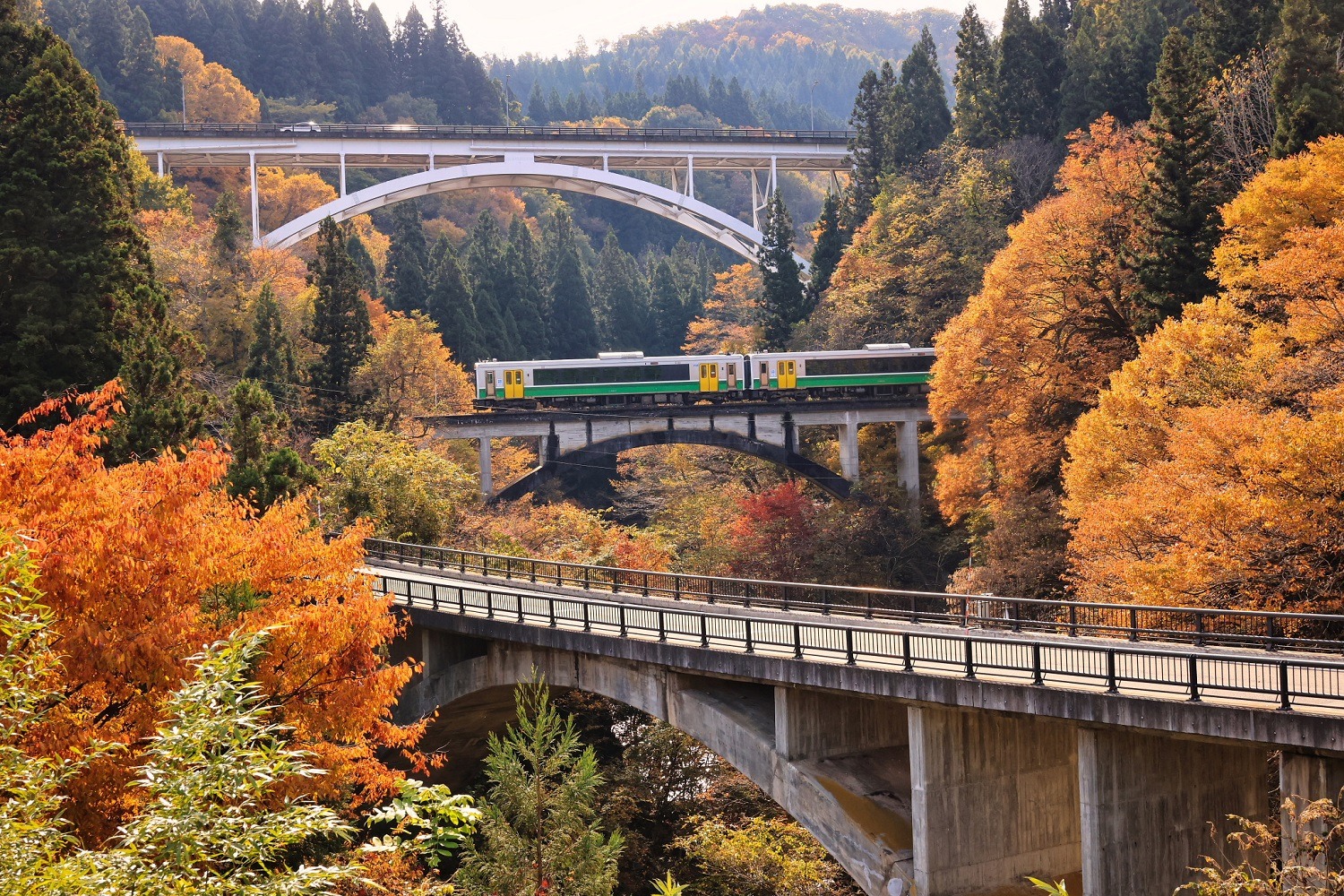
(Miyashita Three Arch Bridge Brothers_Photo courtesy of 星 賢孝)
In addition, along the Tadami Line, there are multiple spots where you can see spectacular views of autumn leaves, bridges, and trains, such as the Second Tadami River Bridge located about 400 meters from Aizu-Nishikata Station on Route 400, the Third Tadami River Bridge along Route 252 between Aizu-Miyashita Station and Hayato Station, and the Fourth Tadami River Bridge between Aizu-Mizunuma Station and Aizu-Nakagawa Station. The autumn leaves, bridges, and trains make for a spectacular sight that lives up to its reputation of being a hidden gem local line with spectacular views. The best time to see the autumn leaves along the Tadami Line is from late October to early November.
When traveling on a local train line such as the Tadami Line, waiting for the next train is an inevitable part of the trip. Here are some spots near the station where you can have fun while waiting.
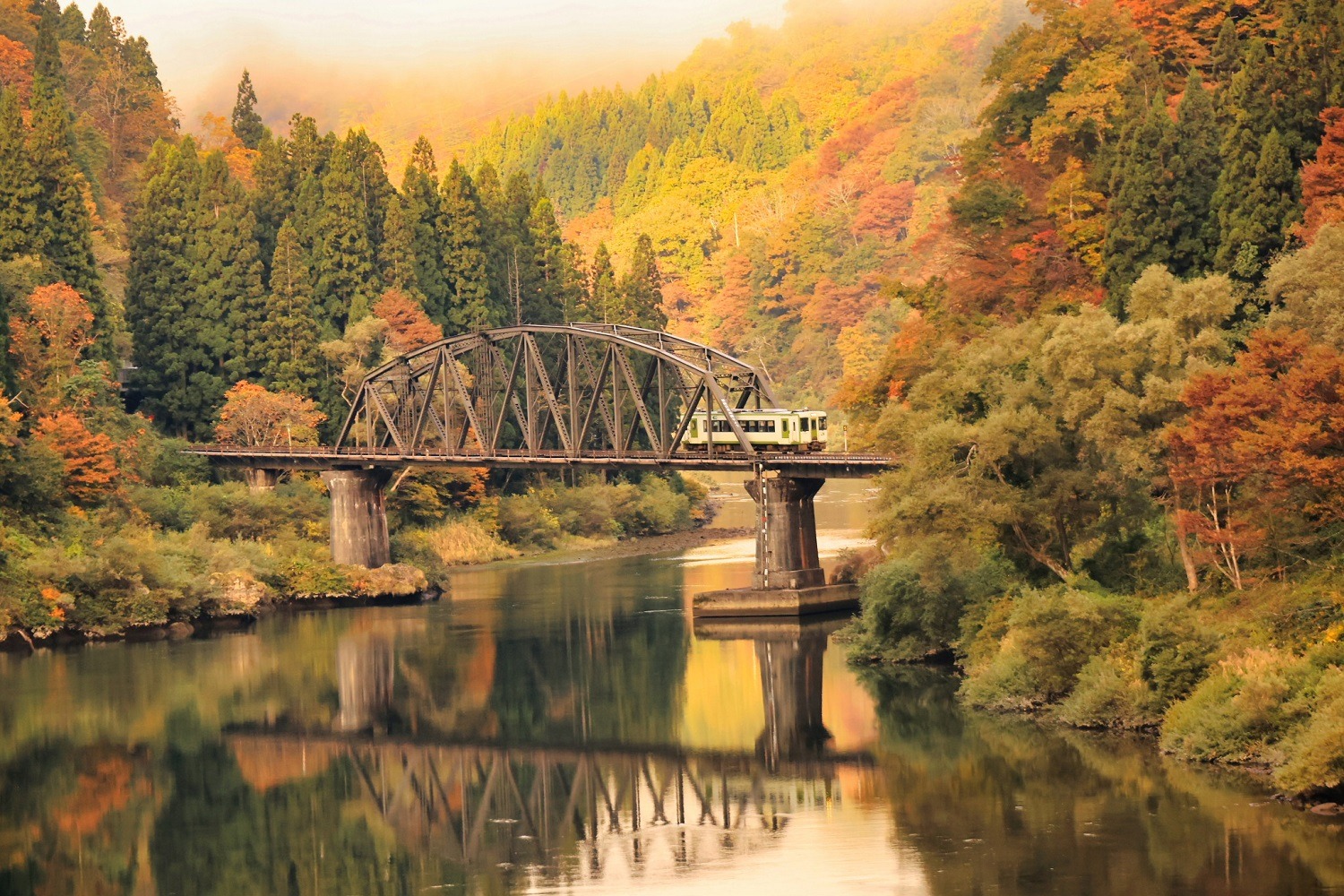
(the Fourth Tadami River Bridge__Photo courtesy of 星 賢孝)
Near Aizu-Miyashita Station, where you get off when heading to the First Tadami River Bridge Viewing Spot, there is a tourist information center and rest stop called "Tourist Exchange Center Karankoron." It features a cafe and a shop selling local products inside a renovated traditional kominka house that will bring you back in time. There is also a tourist information center where you can ask questions about nearby tourist attractions. There is also a rental place for electric-assisted bicycles, so we recommend renting a bicycle and exploring the neighborhood.
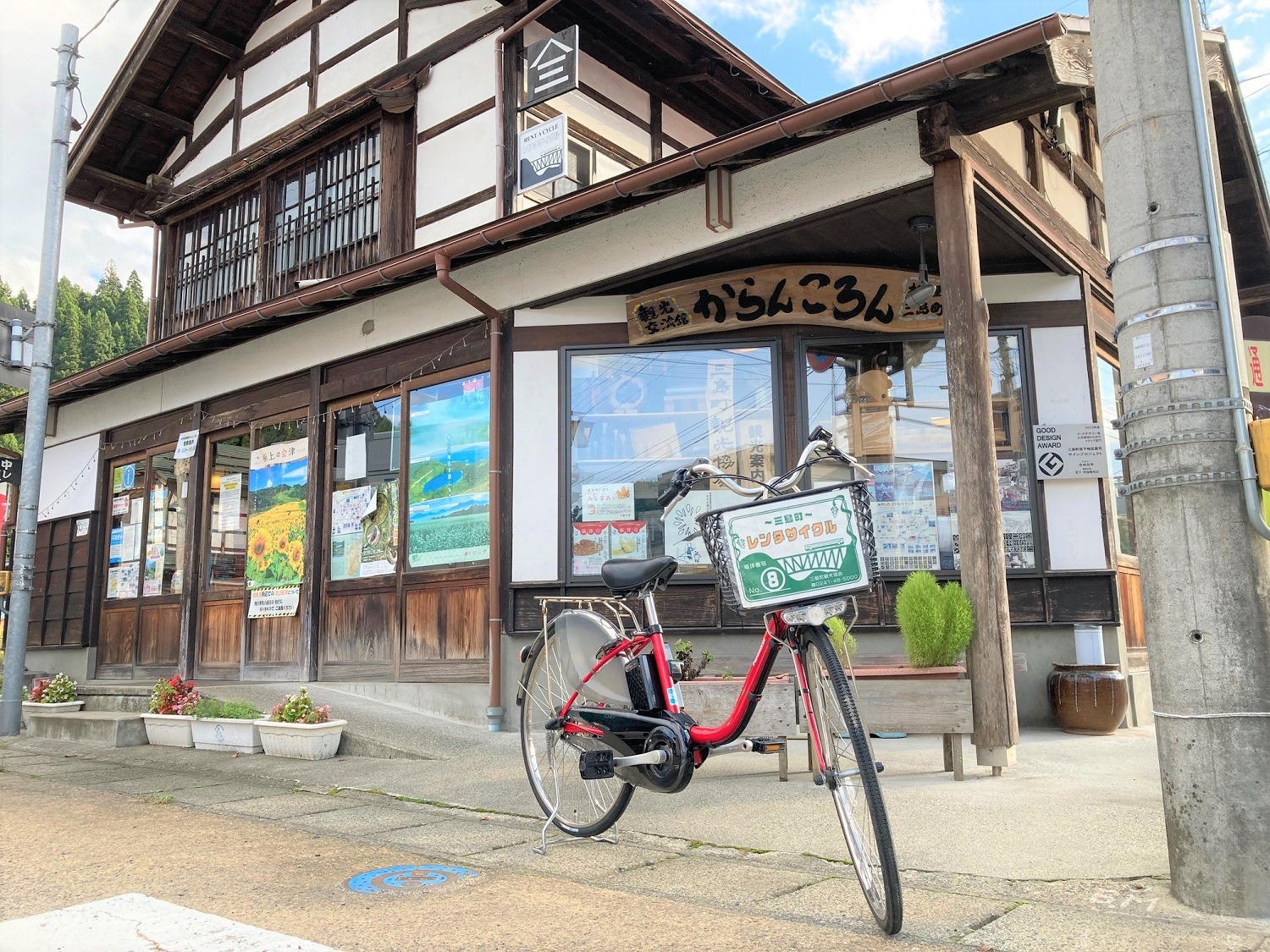 At the entrance to the promenade leading to the First Tadami River Bridge Viewing Spot is the "Michi-no-Eki Oze-Kaido Mishima-juku," which is a popular resting spot for tourists. At the cafeteria, try local specialties such as Aizu Jidori chicken Oyakodon and Aizu soba noodles. You can also purchase local specialty products such as products made with Aizu paulownia wood and wild vegetables.
At the entrance to the promenade leading to the First Tadami River Bridge Viewing Spot is the "Michi-no-Eki Oze-Kaido Mishima-juku," which is a popular resting spot for tourists. At the cafeteria, try local specialties such as Aizu Jidori chicken Oyakodon and Aizu soba noodles. You can also purchase local specialty products such as products made with Aizu paulownia wood and wild vegetables.
A sacred mountain: Autumn leaves viewing at Mt. Yahiko
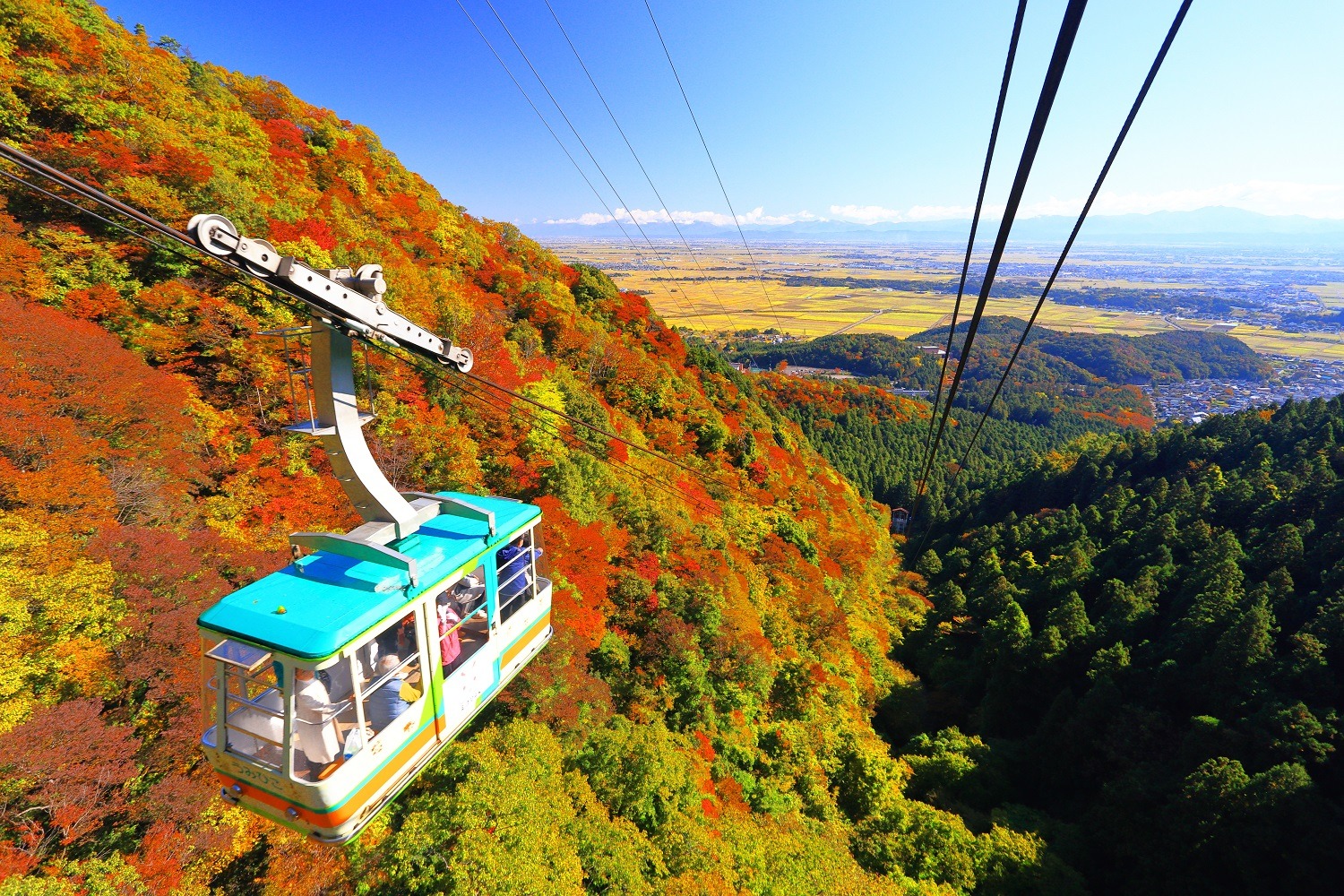
Standing tall in the center of the Echigo Plain, Mt. Yahiko can be seen from anywhere on the plain. The natural forests surrounding Mt. Yahiko exhibit a splendid array of colors in autumn.
At the foot of the mountain is Echigo’s most important shrine, "Yahiko Shrine," and at the top of the mountain is the inner shrine, where the enshrined deity and consort of Yahiko Shrine are enshrined. Yahiko has long been revered as a sacred mountain, and even today the entire mountain is a sacred place, making it one of the most popular spots in Niigata to go to experience the majesty of nature.
Mt. Yahiko stands at 634m, making it the same height as Tokyo Skytree. There are three ways to reach the top of Mt. Yahiko: mountain climbing, ropeway, and car (via the Yahikoyama Skyline). To get there by hiking, start from the Omotesando trailhead by the Haiden (worship hall) of Yahiko Shrine, a 15-minute walk from JR Yahiko Station. Even beginners can climb the mountain in about 90 minutes. The mountain trails are well-maintained and relatively easy to walk, perfect for children hiking for the first time.
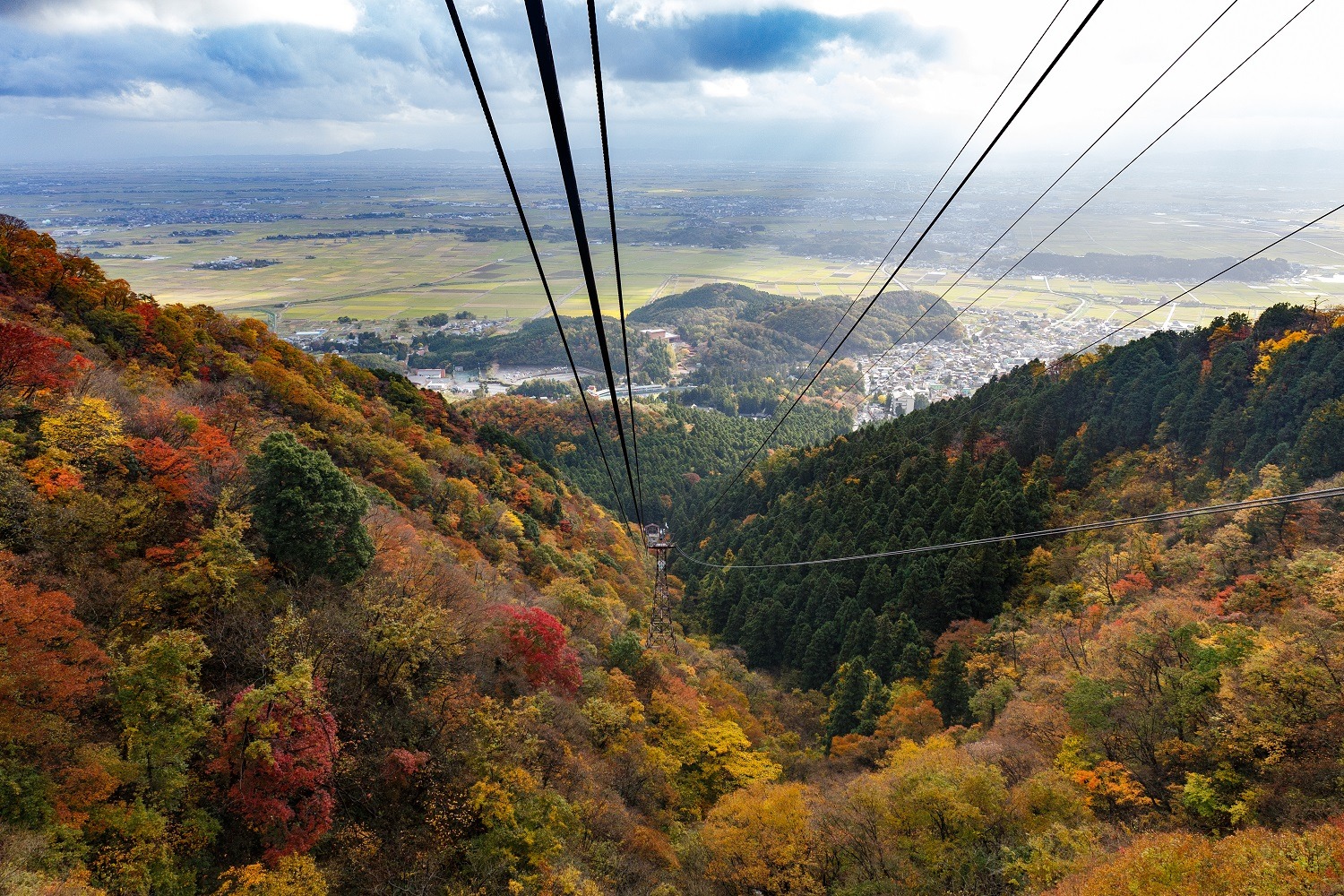
If you use the ropeway, you will depart from the station at the foot of the mountain and arrive at Yahiko Summit Park at the 9th station. While traveling, you can enjoy the majestic Echigo Plain and mountains, as well as autumn leaves from a different perspective than usual. After about 5 minutes of amazing views from above, you will arrive at Summit Park, and then aim for the summit on foot.
Yahiko Summit Park has a rotating observation tower, the Panorama Tower. The observation deck rotates as it ascends and descends the 100-meter-high tower, offering 360-degree panoramic views. There is also an observatory restaurant overlooking the Sea of Japan, so it is the perfect place to take a break.
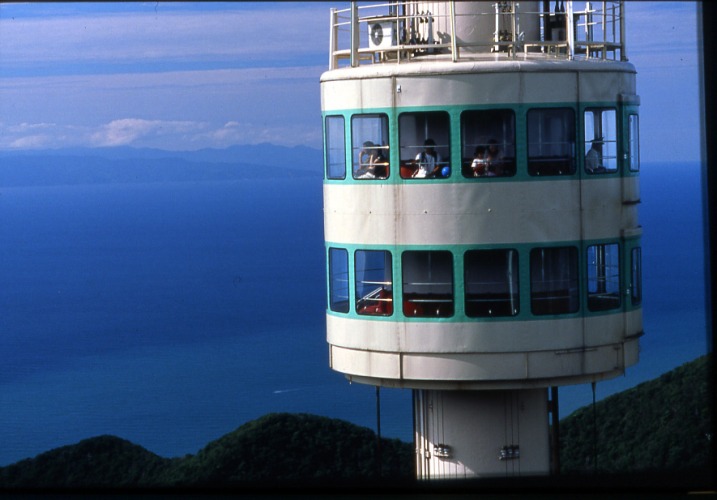 After a short hike from the park, you will reach the summit of the mountain where the Goshinmyo (mausoleum) of Yahiko Shrine is enshrined. Remember to put your hands together and thank the gods for a safe hike before descending the mountain.
After a short hike from the park, you will reach the summit of the mountain where the Goshinmyo (mausoleum) of Yahiko Shrine is enshrined. Remember to put your hands together and thank the gods for a safe hike before descending the mountain.
Yahiko Shrine is a must-visit while hiking around Mt. Yahiko. The shrine is said to have a history of more than 2,400 years since its foundation, and its majestic worship halls and other structures stand side-by-side in the shrine's large grounds of approximately 130,000 square meters. During the autumn foliage season, the famous "Yahiko Chrysanthemum Festival" is held on the shrine grounds. Be sure to take a good look at the large chrysanthemums while visiting the shrine.
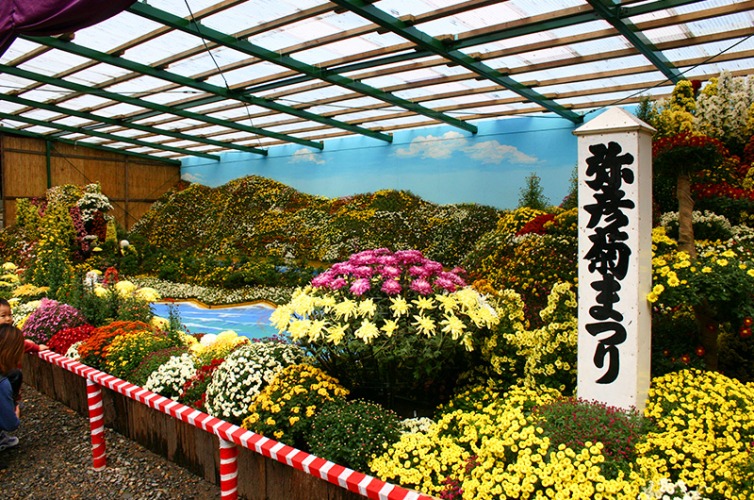
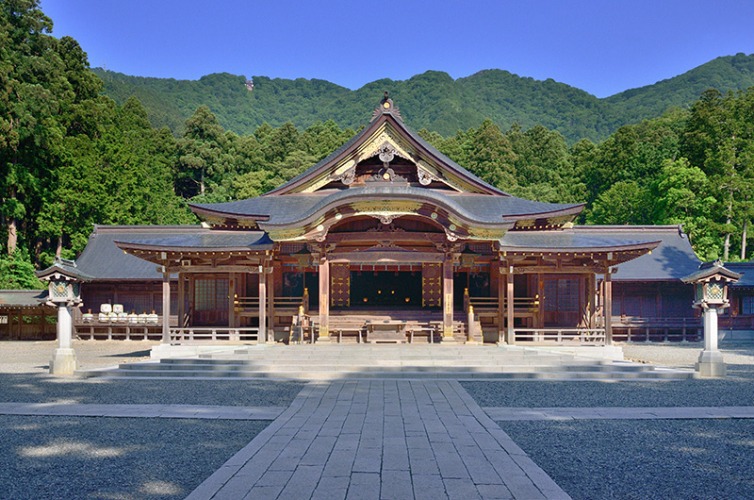 Yahiko Onsen is located at the foot of the eastern side of Mt. Yahiko. It has prospered since ancient times as a hot spring town where visitors to Yahiko Shrine stay. In the center of the hot spring town is the shopping complex "Omotenashi Hiroba." There is a farm stand selling agricultural products from Yahiko Village, as well as sweet stores selling seasonal local fruit sandwiches and cute retro cream sodas. Go check it out and relax after viewing the autumn leaves.
Yahiko Onsen is located at the foot of the eastern side of Mt. Yahiko. It has prospered since ancient times as a hot spring town where visitors to Yahiko Shrine stay. In the center of the hot spring town is the shopping complex "Omotenashi Hiroba." There is a farm stand selling agricultural products from Yahiko Village, as well as sweet stores selling seasonal local fruit sandwiches and cute retro cream sodas. Go check it out and relax after viewing the autumn leaves.
 The best time to see the autumn leaves on Mt. Yahiko is from late October to mid-November.
The best time to see the autumn leaves on Mt. Yahiko is from late October to mid-November.
Tohoku and Niigata have some of the best autumn foliage viewing spots in Japan
As autumn deepens, the autumn leaves quietly and colorfully spread from the mountains at higher elevations to the plains and cities. Each year in Japan, Tohoku is one of the first areas for the autumn leaves to change colors. There are many locations that are not easily accessible, especially those that are only reached by hiking mountains or riding local train lines, that are full of spectacular moving views and that can only be fully appreciated in person. Experience Tohoku and Niigata's spectacular autumn foliage for yourself!